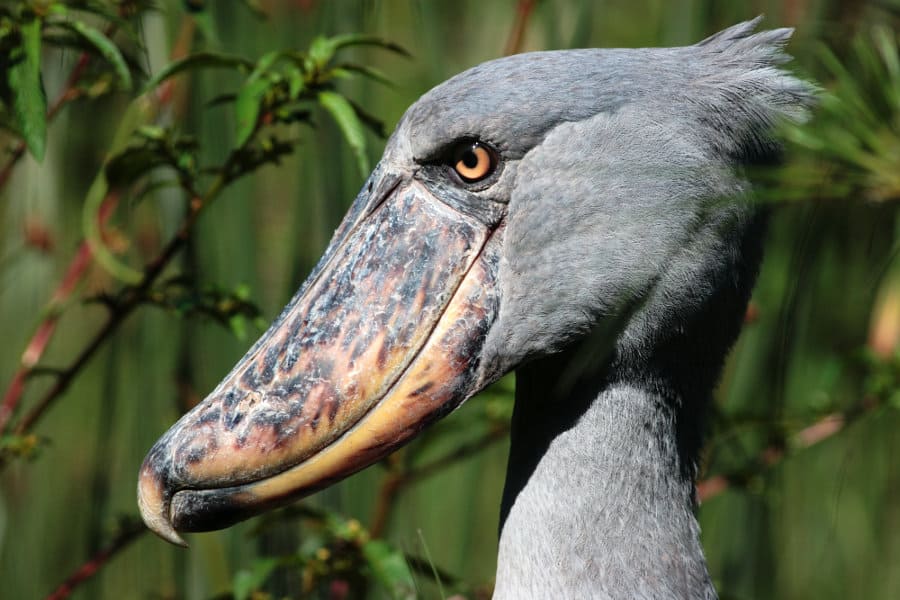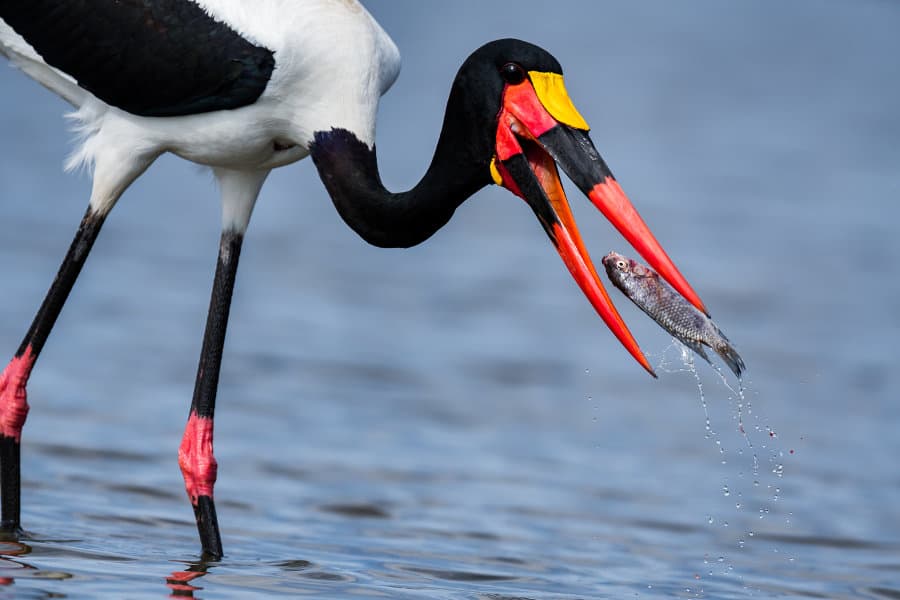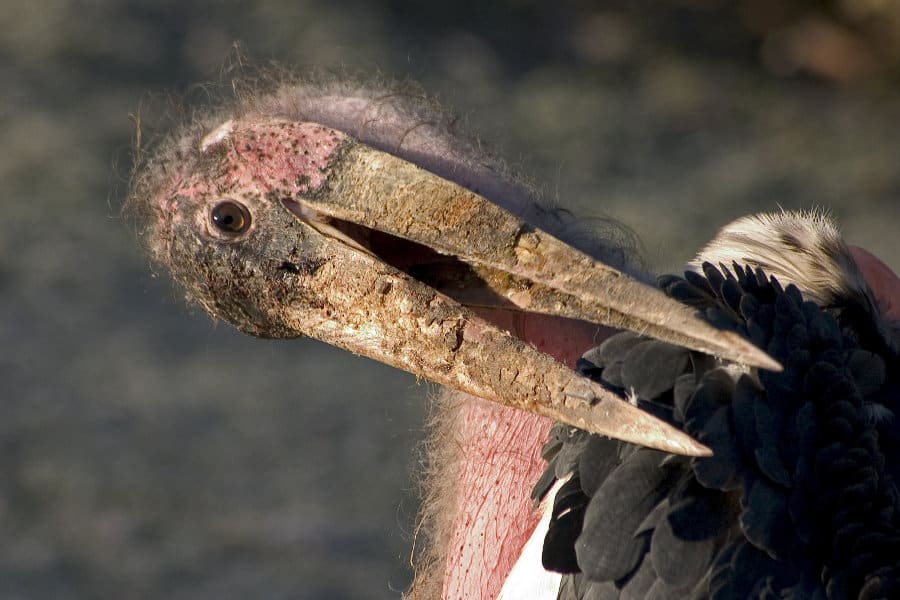The shoebill is so badass that it eats crocodiles.
Yep, it is true that this African bird hunts crocodiles, along with other animals like snakes and monitor lizards.
Not only that, shoebills make a noise that sounds like a machine gun on auto fire.
They also look like some kind of prehistoric leftover, with a jagged shoe-shaped bill that seems to come from fiction.
This is probably the most bizarre bird in the world.
To learn more about the shoebill, here are 17 amazing facts.
Interested in learning about another not-so-pretty bird?
Check out these interesting facts about the marabou stork.
1. Shoebill Stork Size (They’re Enormous)

Before questioning the crocodile diet you need to understand just how big these birds are.
Shoebill stork height
Shoebills measure over a meter in height, and most mature specimens reach 1.3 meters. Measure from the bill to the beak and that’s also a good 1.3 meters.
Shoebill stork weight
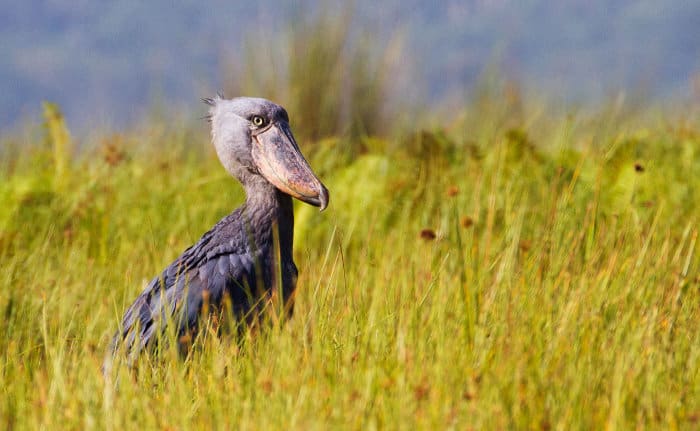
Males hit the scales at a solid 5-6 kg, with the biggest individuals coming in at over 7 kg (15 lb).
Females are only slightly smaller, and really, a bird that big is always going to be unpredictable.
Shoebill stork wingspan
Swans are scary enough, and they don’t have a razor-like beak. With a wingspan of over 2 ½ meters, the shoebill can fly effortlessly across the African skies, although it doesn’t tend to fly very far.
2. Shoebill Eating Crocodile? Yes, It’s True
Shoebill stork eating crocodile? While hard to believe, it is true. The remarkable thing is that crocodiles aren’t even the largest of their prey. A baby Nile crocodile isn’t even a challenge for these hunting birds.
Shoebills have also been known to hunt and kill red lechwe, a semi-aquatic antelope that lives in the swamps of Botswana and Zambia.
Fully-grown red lechwe weigh over 100 kg. They will use the water to stay clear of predators. Baby red lechwe only weigh a few kilograms, and they may end up wading straight into a shoebill trap.
Do note that these shoebill versus red lechwe reports are unconfirmed. But even just to suggest such a thing is an indication of how successful these birds can be.
3. The Classic Shoebill Diet
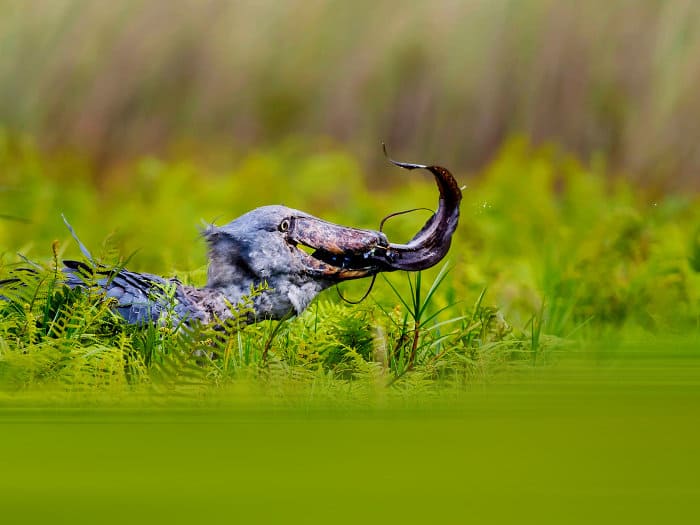
Wondering what do shoebills eat? While they are known as the bird that eats crocodiles, there is much more to the shoebill stork diet.
That’s not to say that large antelope and crocodiles are part of their everyday diet. Shoebills do have strong stomachs and can wolf down just about any animal.
However, they mostly hunt fish. Among their preferred victims are catfish, lungfish, and tilapia.
Along with these piscivorous habits, the shoebill will prey on turtles, snails, rodents, waterfowl, frogs, water snakes, monitor lizards, and Nile crocodiles.
4. Are Shoebills Dangerous to Humans?

Can a shoebill stork kill you? Well, considering they are likely to win the “shoebill vs crocodile” war, one could say maybe. However, we cannot confirm this as these birds are highly unlikely to attack humans.
In fact, shoebill storks are very docile towards humans. Researchers have been able to come within six feet of these prehistoric birds and their nests.
The shoebill bird will not threaten humans; they will simply stare back. Though this can be intimidating given that, when you put a shoebill stork next to a person, they are tall enough to meet them at eye level.
5. Shoebill Hunting Techniques (They’re Stealthy)
When shoebills hunt, they know exactly how to find what they want. Instead of wasting energy flying around, a shoebill will find a prime spot of swamp and play dead.
They stand motionless, not moving a single feather. And then bam! The crocodile has been captured in a violent and instant strike!
When prey comes within range, the shoebill lunges forward, opens its beak, and grabs everything in range. That includes mud, water, grass, and its target.
Remember, these birds are large enough to pass the height test for any theme park ride. Imagine a 1.3-meter bird lunging at you with a razored beak!
6. Shoebill Stork Attack and Decapitate Their Prey

These giant birds are named after their huge bills (also known as a beak). It must have been named by colonialists who believed the bill was so large it could fit a shoe.
This bill culminates in a powerful hooked-over culmen that’s capable of piercing the skin of its prey. When the shoebill launches an attack, it literally impales the prey inside its mouth.
Now comes the gruesome part. With the prey firmly clamped, the bird violently swings its head back and forth. This will remove all the mud and water that was inhaled and lead to the dramatic conclusion: decapitation.
Using that razor-sharp beak, the shoebill rips the head of its prey before proceeding to swallow its victim.
7. Can Shoebill Fly? Yes, But They’re Pretty Slow
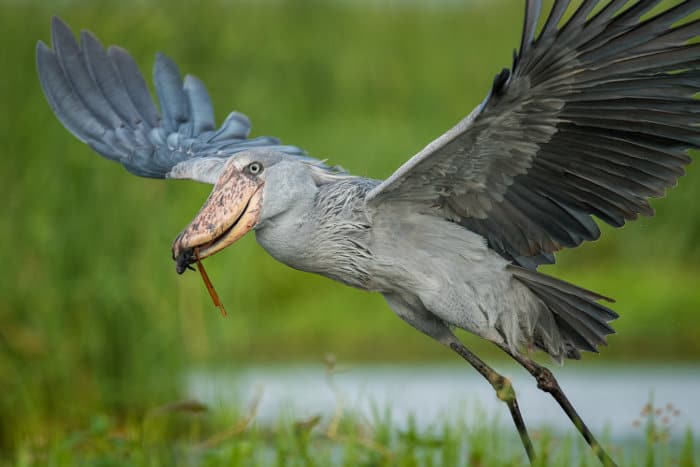
Can shoebill storks fly? Yes, but they have one of the slowest flapping rates of any bird other than large storks.
A hummingbird flaps its wings 4200 times a minute. A shoebill can only do 150 flaps a minute, and that is at full speed. Usually, they flap for seven seconds, glide for seven, flap for seven, glide for seven, etc.
8. Shoebills Are Mostly Native to Tropical East Africa
Okay, it all sounds a little violent, but so is watching a lion devour a zebra carcass, and that’s a premier highlight of a safari. So, where can you admire these incredible carnivorous birds?
Shoebills prefer a tropical climate and live around the water, typically swamps but also deltas and muddy rivers.
Mostly they inhabit Zambia, Malawi, Tanzania, Kenya, Uganda, the Democratic Republic of Congo, and Sudan. There is also an isolated population in the Okavango Delta.
9. A Shoebill’s Best Friend is a Hippo

Over the centuries, they’ve developed a great relationship with hippos (sometimes called river horses).
The four-legged giants stir up mud and silt, which forces fish towards the surface where there is more oxygen.
That puts them in shoebill hunting range.
10. They’ve Been Revered Since the Time of the Ancient Egyptians
Shoebills appear in the hieroglyphic artwork of the ancient Egyptians.
It’s likely that they lived in Egypt 3000 years ago but were hunted to extinction there.
11. In Arabic the Shoebill is Known as the Father of a Slipper

Even the Persians and Ottomans knew about this weird bird. They called it Abu-Markub, translated as the father of a slipper.
This name is a little better than some of the other English names. Shoebills are still commonly known as the whale-headed stork or simply whalehead.
12. Shoebill Sound – Bird That Sounds Like a Machine Gun
Wondering what a shoebill bird sounds like? Shoebills are solitary animals and are silent for most of the day. But when coming into contact with another bird, the shoebill sounds like a machine gun.
The shoebill stork noise is actually known as bill-clattering. And while it really does sound like a weapon of war, this is how the shoebill calls on the opposite sex.
13. Shoebills Deliberately Crap on Their Own Legs
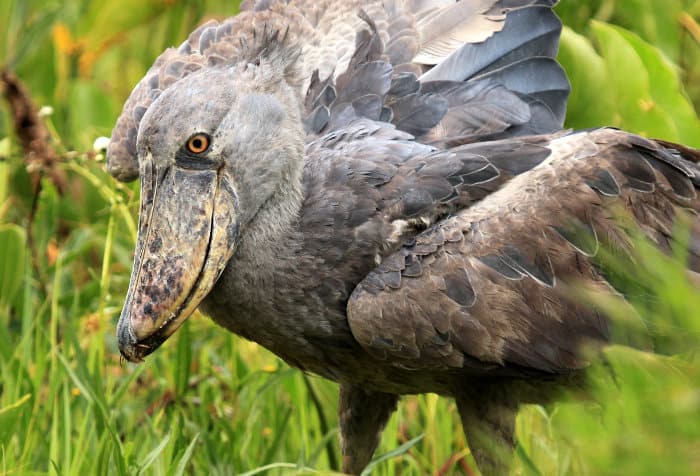
Some animals just can’t help defecating on themselves, such as cows, camels, and all other animals that crap while they are on the move.
Shoebills choose to do it. Defecating on their legs is an expert technique for staying cool.
Their feces is mostly liquid. Warm blood is used to help evaporate the poop, leaving cooler blood to pass through the rest of the bird.
14. Shoebills Are Monogamous Birds
It’s not all weird-looking. These birds can be quite cute as well.
They form monogamous pairs from an early age and aggressively defend their partners against rivals. Getting the best breeding territory is very important, so shoebills will regularly fight with others to protect their spot.
Both the male and female get involved in building the nest and looking after the eggs. They take turns in guarding and feeding the nestling, regurgitating the entire fish for the newborn.
Yet, while shoebills will lay two or three eggs, only one will ever survive.
15. The Violent Behaviour of Shoebill Siblings
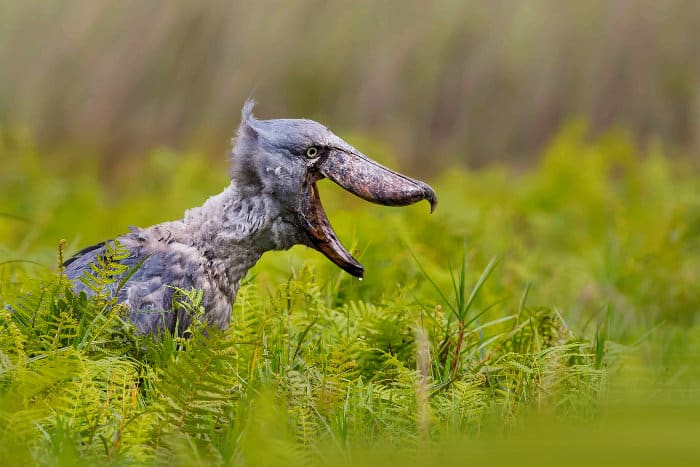
This is Darwin’s theory of natural selection at its darkest. Usually, the eldest chick is the strongest. It will attack and bully its younger sibling in a deliberate and systematic manner.
This behavior is fully supported by the parents. They accept that it’s only possible to raise one youngster. In fact, the second and third eggs are only ever intended to be backups in case something happens to the first.
David Attenborough brilliantly narrates this shoebill behavior in the 2013 BBC series Africa.
16. These Prehistoric Birds Can Live for 35 years
They appear to be a bird from science fiction, and their behavior is far from the charming ways of other birds.
But shoebills are mightily successful. Their lifespan is 30-35 years in the wild. Just imagine how many baby crocodiles one may have eaten over that time.
Chicks are only fully independent after three to four years when they will venture off and find their own territory.
17. The Machine Gun Bird is a Vulnerable Species
According to the IUCN, the shoebill is listed as a vulnerable species. Currently, it is estimated that there are 3300 to 5300 mature adults left in the wild.
However, the population is experiencing a downward trend, so it is only a matter of time before they are considered endangered.
Hear the Unique Shoebill Noise on a Safari
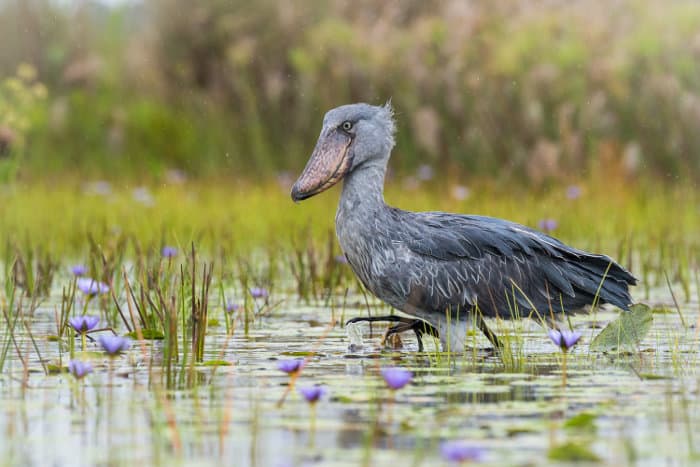
Shoebills weren’t categorized by Western ornithologists until 1851, yet they have quickly risen to become one of the most sought-after birds to see in Africa.
To encounter one in the wild is a special experience, especially to watch one hunting in a swamp.
Note that while the shoebill is not necessarily threatening to humans, it is best that they not be approached.
So when you’re on a safari, be sure to view them from a distance.
When you see a 1.3-meter tall shoebill in the wild, you will quickly understand why they can decapitate a crocodile.
You may also get to hear the shoebill mating call, and grasp why people say these birds sound like machine guns.
Shoebill storks are truly awesome creatures. However, their survival is threatened.
For an opportunity to see some prehistoric birds while they are still around, check out these safari deals.
But hopefully, they will be alive for many decades to come.
